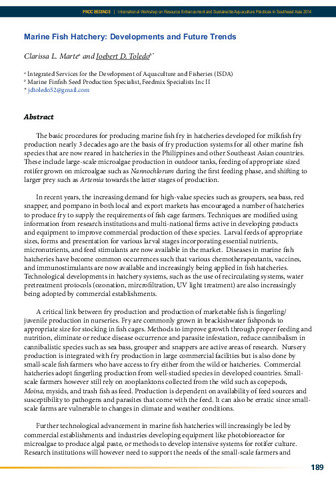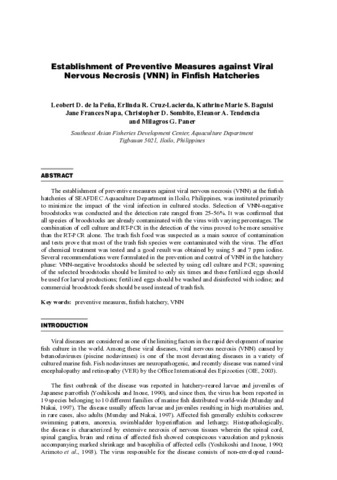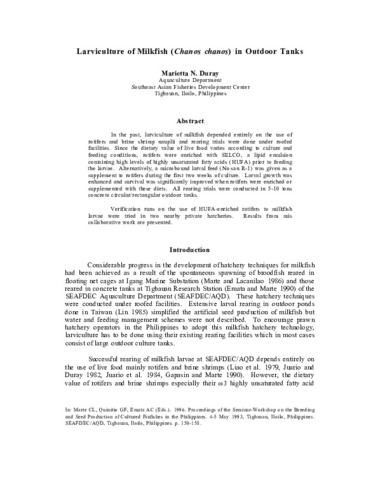Marine fish hatchery: developments and future trends
- Global styles
- MLA
- Vancouver
- Elsevier - Harvard
- APA
- Help

Date
2015Page views
6,234ASFA keyword
AGROVOC keyword
Taxonomic term
Metadata
Show full item record
Share
Abstract
The basic procedures for producing marine fish fry in hatcheries developed for milkfish fry production nearly 3 decades ago are the basis of fry production systems for all other marine fish species that are now reared in hatcheries in the Philippines and other Southeast Asian countries. These include large-scale microalgae production in outdoor tanks, feeding of appropriate sized rotifer grown on microalgae such as Nannochlorum during the first feeding phase, and shifting to larger prey such as Artemia towards the latter stages of production.
In recent years, the increasing demand for high-value species such as groupers, sea bass, red snapper, and pompano in both local and export markets has encouraged a number of hatcheries to produce fry to supply the requirements of fish cage farmers. Techniques are modified using information from research institutions and multi-national firms active in developing products and equipment to improve commercial production of these species. Larval feeds of appropriate sizes, forms and presentation for various larval stages incorporating essential nutrients, micronutrients, and feed stimulants are now available in the market. Diseases in marine fish hatcheries have become common occurrences such that various chemotherapeutants, vaccines, and immunostimulants are now available and increasingly being applied in fish hatcheries. Technological developments in hatchery systems, such as the use of recirculating systems, water pretreatment protocols (ozonation, mircrofiltration, UV light treatment) are also increasingly being adopted by commercial establishments.
A critical link between fry production and production of marketable fish is fingerling/ juvenile production in nurseries. Fry are commonly grown in brackishwater fishponds to appropriate size for stocking in fish cages. Methods to improve growth through proper feeding and nutrition, eliminate or reduce disease occurrence and parasite infestation, reduce cannibalism in cannibalistic species such as sea bass, grouper and snappers are active areas of research. Nursery production is integrated with fry production in large commercial facilities but is also done by small-scale fish farmers who have access to fry either from the wild or hatcheries. Commercial hatcheries adopt fingerling production from well-studied species in developed countries. Smallscale farmers however still rely on zooplanktons collected from the wild such as copepods, Moina, mysids, and trash fish as feed. Production is dependent on availability of feed sources and susceptibility to pathogens and parasites that come with the feed. It can also be erratic since smallscale farms are vulnerable to changes in climate and weather conditions.
Further technological advancement in marine fish hatcheries will increasingly be led by commercial establishments and industries developing equipment like photobioreactor for microalgae to produce algal paste, or methods to develop intensive systems for rotifer culture. Research institutions will however need to support the needs of the small-scale farmers and hatchery operators who may not be able to apply costly products from these companies by developing innovative simple techniques that can improve culture systems such as producing fry and fingerlings in mesocosm pond system, appropriate use of probiotics as water stabilizer, and production of zooplankton in ponds.
Suggested Citation
Marte, C. L., & Toledo, J. D. (2015). Marine fish hatchery: developments and future trends. In M. R. R. Romana-Eguia, F. D. Parado-Estepa, N. D. Salayo, & M. J. H. Lebata-Ramos (Eds.), Resource Enhancement and Sustainable Aquaculture Practices in Southeast Asia: Challenges in Responsible Production of Aquatic Species: Proceedings of the International Workshop on Resource Enhancement and Sustainable Aquaculture Practices in Southeast Asia 2014 (RESA) (pp. 189-200). Tigbauan, Iloilo, Philippines: Aquaculture Dept., Southeast Asian Fisheries Development Center.
Type
Conference paperISBN
9789719931041
Related items
Showing items related by title, author, creator and subject.
-
Establishment of preventive measures against viral nervous necrosis (VNN) in finfish hatcheries
de la Peña, Leobert D.; Cruz-Lacierda, Erlinda R.; Baguisi, Kathrine Marie S.; Napa, Jane Frances; Sombito, Christopher D.; Tendencia, Eleonor ; Paner, Milagros G. (Aquaculture Department, Southeast Asian Fisheries Development Center, 2005-03)
The establishment of preventive measures against viral nervous necrosis (VNN) at the finfish hatcheries of SEAFDEC Aquaculture Department in Iloilo, Philippines, was instituted primarily to minimize the impact of the viral ...
; Paner, Milagros G. (Aquaculture Department, Southeast Asian Fisheries Development Center, 2005-03)
The establishment of preventive measures against viral nervous necrosis (VNN) at the finfish hatcheries of SEAFDEC Aquaculture Department in Iloilo, Philippines, was instituted primarily to minimize the impact of the viral ... -
Larviculture of milkfish (Chanos chanos) in outdoor tanks
Duray, Marietta N. (Aquaculture Department, Southeast Asian Fisheries Development Center, 1996)In the past, larviculture of milkfish depended entirely on the use of rotifers and brine shrimp nauplii and rearing trials were done under roofed facilities. Since the dietary value of live food varies according to culture ... -
Series: Aquaculture extension manual; No. 63
Seed production of milkfish Chanos chanos Forsskal
Reyes, Ofelia; Eullaran, Bernadita; Ayson, Evelyn Grace (Aquaculture Department, Southeast Asian Fisheries Development Center, 2016)A 26-page manual describing the site selection, hatchery design, spawning, larval rearing, natural food production, and economic analysis for milkfish.






